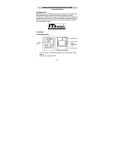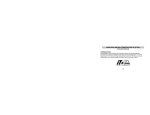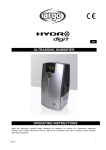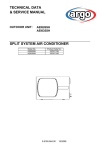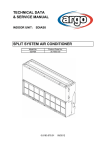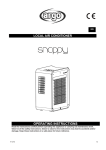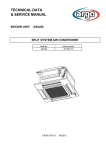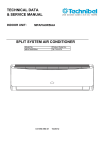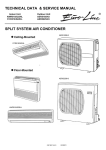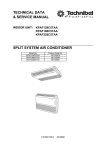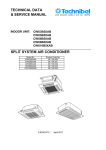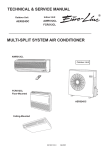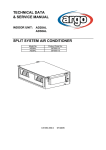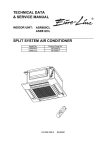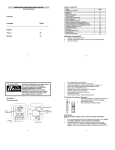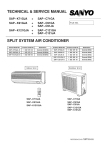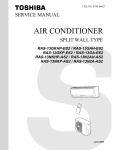Download TECHNICAL DATA & SERVICE MANUAL SPLIT
Transcript
TECHNICAL DATA & SERVICE MANUAL INDOOR UNIT: AWI826HL(B) AWI835HL(B) AWI8826HL(B) AWI8835HL(B) SPLIT SYSTEM AIR CONDITIONER Model No. AWI826HL(B) AWI835HL(B) AWI8826HL(B) AWI8835HL(B) Product Code No. 38.7004.074(078) 38.7004.075(079) 38.7004.076(080) 38.7004.077(081) 0.8180.561.01 Oct 2008 IMPORTANT! Please read before installation This air conditioning system meets strict safety and operating standards. For the installer or service person, it is important to install or service the system so that it operates safely and efficiently. For safe installation and trouble-free operation, you must: • Carefully read this instruction booklet before beginning. • Follow each installation or repair step exactly as shown. • Observe all local, state and national electrical codes. • Pay close attention to all warning and caution notices given in this manual. •The unit must be supplied with a dedicated electrical line. • Ground the unit following local electrical codes. • The Yellow/Green wire cannot be used for any connection different from the ground connection. • Connect all wiring tightly. Loose wiring may cause overheating at connection points and a possible fire hazard. • Do not allow wiring to touch the refrigerant tubing, compressor, or any moving parts of the fan. • Do not use multi-core cable when wiring the power supply and control lines. Use separate cables for each type of line. When transporting Be careful when picking up and moving the indoor and outdoor units. Get a partner to help, and bend your knees when lifting to reduce strain on your back. Sharp edges or thin aluminium fins on the air conditioner can cut your fingers. WARNING This symbol refers to a hazard or unsafe practice which can result in severe personal injury or death. CAUTION This symbol refers to a hazard or unsafe practice which can result in personal injury or product or property damage. If necessary, get help These instructions are all you need for most installation sites and maintenance conditions. If you require help for a special problem, contact our sale/service outlet or your certified dealer for additional instructions. In case of improper installation The manufacturer shall in no way be responsible for improper installation or maintenance service, including failure to follow the instructions in this document. When installing... ... In a ceiling or wall Make sure the ceiling/wall is strong enough to hold the unit-weight. It may be necessary to build a strong wooden or metal frame to provide added support. ... In a room Properly insulate any tubing run inside a room to prevent "sweating", which can cause dripping and water damage to walls and floors. ... In moist or uneven locations Use a raised concrete base to provide a solid level foundation for the outdoor unit. This prevents damage and abnormal vibrations. ... In area with strong winds Securely anchor the outdoor unit down with bolts and a metal frame. Provide a suitable air baffle. ... In a snowy area (for heat pump-type systems) Install the outdoor unit on a raised platform that is higher than drifting snow. Provide snow vents. SPECIAL PRECAUTIONS • During installation, connect before the refrigerant system and then the wiring one; proceed in the reverse orden when removing the units. WARNING When wiring ELECTRICAL SHOCK CAN CAUSE SEVERE PERSONAL INJURY OR DEATH. ONLY A QUALIFIED, EXPERIENCED ELECTRICIANS SHOULD ATTEMPT TO WIRE THIS SYSTEM. • Do not supply power to the unit until all wiring and tubing are completed or reconnected and checked, to ensure the grounding. • Highly dangerous electrical voltages are used in this system. Carefully refer to the wiring diagram and these instructions when wiring. Improper connections and inadequate grounding can cause accidental injury and death. 2 When connecting refrigerant tubing • Keep all tubing runs as short as possible. • Use the flare method for connecting tubing. • Apply refrigerant lubricant to the matching surfaces of the flare and union tubes before connecting them; screw by hand and then tighten the nut with a torque wrench for a leak-free connection. • Check carefully for leaks before starting the test run. NOTE: Depending on the system type, liquid and gas lines may be either narrow or wide. Therefore, to avoid confusion, the refrigerant tubing for your particular model is specified as narrow tube for liquid, wide tube for gas. When servicing • Turn the power OFF at the main power board before opening the unit to check or repair electrical parts and wiring. • Keep your fingers and clothing away from any moving parts. • Clean up the site after the work, remembering to check that no metal scraps or bits of wiring have been left inside the unit being serviced. • Ventilate the room during the installation or testng the refrigeration system; make sure that, after the installation, no gas leaks are present, because this could produce toxic gas and dangerous if in contact with flames or heat-sources. Table of Contents Page 4 4 6 8 1. SPECIFICATIONS 1-1 Unit specifications 1-2 Major Component specifications 1-3 Other Component specifications 9 2. DIMENSIONAL DATA 10 11 3. PERFORMANCE DATA 3-1 Air Throw Distance Chart 12 12 4. ELECTRICAL DATA 4-1 Electric Wiring Diagrams 13 13 14 14 15 16 16 16 17 17 18 19 19 19 20 20 20 21 22 23 23 25 5. FUNCTION 5-1 System operation control 5-2 Cool Mode Operation 5-3 Heat Mode Operation 5-4 Auto Mode Operation 5-5 Dry Mode Operation 5-6 Fan Mode Operation 5-7 Auto Fan Speed 5-8 Forced-Made 5-9 Protection Operations in indoor unit 5-10 Protection Operation outdoor unit 5-11 Defrost 5-12 I Feel Function 5-13 Hi Power mode 5-14 Night Function 5-15 Leds off function 5-16 Capacity Test Mode 5-17 Diagnostic 5-18 Indoor unit jumpers Configuration 5-19 Outdoor unit jumpers Configuration 5-20 Contacts for building automation 5-21 Maintenance 6. TROUBLESHOOTING 6-1 Check before and after troubleshooting 6-2 Circuit Breaker Trips or Fuse Blows 6-3 Unit does not run 6-4 Unit does not run with regular led signalation 6-5 Only external unit is off 6-6 Air Conditioner operates, but abnormalities aer observed 6-7 Air Conditioner operates, but abnormalities aer observed 6-8 Noisy problem 7. CHECKING ELETRICAL COMPONENTS 7-1 Measurement of Insulation Resistance 7-2 Checking Continuity of Fuse on PCB Ass'y 3 26 26 26 27 29 29 30 31 33 34 34 35 1. SPECIFICATIONS 1-1 Unit Specifications AWI826HL(B) AWI835HL(B) Power source 220 - 240 V ~ 50 Hz Voltage rating 230 V - 50 Hz Performance Capacity Air circulation (High) m³/h Features Controls/Temperature controls Control unit Timer Fan speed Airflow direction Air Filter Power noise level Refrigerant tubing connections Refrigerant tube diameter Refrigerant Refrigerant tube kit / Air clean filter Dimensions & Weight Unit dimensions Package dimensions Weight Horizontal Vertical High/Med./Low Narrow tube Wide tube dB-A mm(in.) mm(in.) Cooling Heating See catalogue with the requested matching 530 Microprocessor/ I.C. thermostat Wireless remote control unit ON/OFF 24 hours 4 and Auto Manual Auto Washable, Anti-Mold 39/36/29/21 Flare type 6.35 (1/4) 9.52 (3/8) R410A Optional / Optional 305 mm 895 mm 195 ( 110 Built-in ) mm 350 mm 950 mm 265 mm 12.00 kg 13 kg 0.088 m3 DATA SUBJECT TO CHANGE WITHOUT NOTICE Height Width Depth Height Width Depth Net Shipping Shipping volume 4 AWI8826HL(B) AWI8835HL(B) Power source 220 - 240 V ~ 50 Hz Voltage rating 230 V - 50 Hz Performance Capacity Air circulation (High) m³/h Features Controls/Temperature controls Control unit Timer Fan speed Airflow direction Air Filter Power noise level Refrigerant tubing connections Refrigerant tube diameter Refrigerant Refrigerant tube kit / Air clean filter Dimensions & Weight Unit dimensions Package dimensions Weight Horizontal Vertical High/Med./Low Narrow tube Wide tube dB-A mm(in.) mm(in.) Cooling Heating See catalogue with the requested matching 600 Microprocessor/ I.C. thermostat Wireless remote control unit ON/OFF 24 hours 4 and Auto Manual Auto Washable, Anti-Mold 39/36/29/21 Flare type 6.35 (1/4) 9.52 (3/8) R410A Optional / Optional 305 mm 895 mm 195 ( 110 Built-in ) mm 350 mm 950 mm 265 mm 12.00 kg 13 kg 0.088 m3 DATA SUBJECT TO CHANGE WITHOUT NOTICE Height Width Depth Height Width Depth Net Shipping Shipping volume 5 1-2 Major Component Specifications AWI826HL(B) AWI835HL(B) Controller PCB Part No. Controls Control circuit fuse SAC DCI IDU Microprocessor 250 V - 3,15 A Remote Control Unit SAC W-REM Fan & Fan Motor Type Q'ty ……. Dia. and lenght Fan motor model…Q'ty No. Of poles…rpm (230 V, Hi) Nominal output Coil resistance (Ambient temp. 20 °C ) Safety devices mm W Ω Type Operating temp. Open Close Run capacitor °C µF VAC Functional Flap Motor / Aesthetics Flap Motor Type Model Rating Coil resistance (Ambient temp. 25 °C ) Ω Heat Exch. Coil Coil Rows Fin pitch Face area Cross - flow 1…. Ø 90,5 / L 669,5 KFV4Q-11SB5P…1 4…1160 10 BRN-WHT: 561,8 VLT-WHT: 197,4 VLT-ORG: 63,4 YEL-ORG: 155,7 YEL-PNK: 115,9 internal fuse 145 ± 5 1 440 Stepping motor MP24Z2 / MP24Z DC 12 V 380 ± 7% Aluminium plate fin / Copper tube 2 1,3 mm 0,150 DATA SUBJECT TO CHANGE WITHOUT NOTICE 6 AWI8826HL(B) AWI8835HL(B) Controller PCB Part No. Controls Control circuit fuse SAC DCI IDU Microprocessor 250 V - 3,15 A Remote Control Unit SAC W-REM Fan & Fan Motor Type Q'ty ……. Dia. and lenght Fan motor model…Q'ty No. Of poles…rpm (230 V, Hi) Nominal output Coil resistance (Ambient temp. 20 °C ) Safety devices mm W Ω Type Operating temp. Open Close Run capacitor °C µF VAC Functional Flap Motor / Aesthetics Flap Motor Type Model Rating Coil resistance (Ambient temp. 25 °C ) Ω Heat Exch. Coil Coil Rows Fin pitch Face area Cross - flow 1…. Ø 90,5 / L 669,5 KFV4Q-11SB5P…1 4…1160 10 BRN-WHT: 561,8 VLT-WHT: 197,4 VLT-ORG: 63,4 YEL-ORG: 155,7 YEL-PNK: 115,9 internal fuse 145 ± 5 1 440 Stepping motor MP24Z2 / MP24Z DC 12 V 380 ± 7% Aluminium plate fin / Copper tube 2 1,3 mm 0,23785 DATA SUBJECT TO CHANGE WITHOUT NOTICE 7 1-3 Other Component Specifications Trasformer (TR) Rating Coil resistance AWI826HL(B) AWI835HL(B) AWI8826HL(B) AWI8835HL(B) 0028TRA008 AC 230 V, 50 Hz 13 V - 6VA Primary Secondary Capacity Ω (at 25°C) Primary: Secondary: 120°C Thermal cut-off temp. Thermistor ( Coil sensor ) Resistance kΩ NTC-THERMISTOR 10 at 25 °C Thermistor ( Room sensor ) Resistance kΩ NTC-THERMISTOR 10 at 25 °C 8 2. DIMENSIONAL DATA AWI826HL(B) AWI835HL(B) AWI8826HL(B) AWI8835HL(B) 9 3. PERFORMANCE DATA 3-1 Air Throw Distance Chart AWI826HL(B) AWI8826HL(B) Cooling Room air temp. : Fan speed : 27°C High Horizontal distance (m) 0 1 2 3 4 5 6 7 8 9 8 9 Axis air verocity (m/s) Vertical distance (m) 0 1 2 3 4 : Flap angle 0° , : Flap angle 30°, : Axis air velocity 0° : Axis air velocity 30° Heating Room air temp. : Fan speed : 20°C High Horizontal distance (m) 0 1 2 3 4 5 6 7 Axis air verocity (m/s) Vertical distance (m) 0 1 2 3 4 : Flap angle 45° , : Flap angle 60° , 10 : Axis air velocity 45° : Axis air velocity 60° AWI835HL(B) AWI8835HL(B) Cooling Room air temp. : Fan speed : 27°C High Horizontal distance (m) 0 1 2 3 4 5 6 7 8 9 8 9 Axis air verocity (m/s) Vertical distance (m) 0 1 2 3 4 : Flap angle 0° , : Flap angle 30°, : Axis air velocity 0° : Axis air velocity 30° Heating Room air temp. : Fan speed : 20°C High Horizontal distance (m) 0 1 2 3 4 5 6 7 Axis air verocity (m/s) Vertical distance (m) 0 1 2 3 4 : Flap angle 45° , : Flap angle 60° , 11 : Axis air velocity 45° : Axis air velocity 60° 4. ELECTRICAL DATA 4-1 Electric Wiring Diagrams AWI826HL(B) AWI835HL(B) AWI8826HL(B) AWI8835HL(B) 12 5.FUNCTION 5-1 System operation control The inputs to the systems come from indoor and outdoor sensors. The outdoor unit is the system MASTER while the indoor one is the SLAVE. Communication between units is made with a 2 poles RS485 bus The indoor units receives the user input (fan speed, flap position etc) through remote controller which sends signal every time a button is pressed and in any case, automatically, every 5 minutes. 5.1.1 control specification During operation compressor speed can be subjected to change due to thermal load variations or protection activations but in any case: • The minimum time interval between an OFF and a ON operation is not lower than 3 minutes • The minimum operating time is not lower than 3 minutes • The acceleration/deceleration rate is fixed at 50rpm /sec • During the start-up compressor speed increases according to a defined rule which is independent from the thermal load calculation. 13 5-2 Cool Mode Operation In Cooling Mode, the operation of the compressor (CM), Outdoor Fan (FMO) and Indoor Fan (FMI) are determined by: 1) the difference between the room air temperature (RAT) and the set point temperature (SPT) 2) the protection level at which the system is operating NOTES In addition to the temperature difference of above, the operation of the main components (CM, FMO, FMI) is also controlled by protection function. The minimum off time of compressor is 3 minutes. The indoor fan can change speed only after it has operated at the same speed for 30 sec if in AUTO and 1 sec for the other settings (High, Med, Low). 5-3 Heat Mode Operation The Heating mode operation is similar to the Cooling mode operation. The CM, FMO and FMI are controlled by the same parameters. NOTES 1. After the CM has stopped, the FMI runs for 30s in order to purge heat from the indoor coil. 2. The FMI will not be turned on until the indoor coil temperature is warm enough to prevent the supply of cold air (see COLD DRAFT PREVENTION feature for details). The indoor fan can change speed only after it has operated at the same speed for 30 sec if in AUTO and 1 sec for the other settings (High, Med, Low). 14 5-4 Auto Mode Operation In Auto Mode, the unit switches automatically between the Auto Cooling and Auto Heating in order to maintain the room temperature (RAT) at the prescribed set point (SPT). The switching between the two modes is according to the above graph and following table COOLING ---> HEATING If -3°C ≤ Dt ≤-1°C and the compressor is off for more than 1 hour If Dt ≤ -3°C and compressor is off for more than 3 minutes HEATING ---> COOLING If 1°C ≤ Dt ≤ 3°C and the compressor is off for more than 1 hour If Dt ≥ 3°C and compressor is off for more than 3 minutes Dt = RAT - SPT Refer to the sections 5.1 COOLING MODE and 5.2 HEATING MODE for system operation details. 15 5-5 Dry Mode Operation Dry operation remove moisture from indoor air running, in cooling mode, at a low level without reducing the ambient temperature. This is done cycling ON and OFF indoor and outdoor units according to below. ROOM TEMP DRY LEVEL ≥ SPT+2°C LEVEL 0 < SPT+2°C ≥ SPT-1°C < SPT-1°C ≥ 15°C < 15°C Operation according to COOLING mode CM on at constant speed FMO on at constant speed FMI switches between L and LL every 30 seconds RV off CM switches 9 minutes off and 3 minutes on LEVEL 2 FMO switches 9 minutes off and 3 minutes ON FMI switches between L and LL every 30 seconds RV off CM off DRY OFF ZONE FMO off FMI off RV off LEVEL 1 SPT = Set Point Temperature 5-6 Fan Mode Operation With this mode, the indoor fan is turned on while CM, FMO and RV stay off all the time. The user can select between 3 speeds: HIGH, MEDIUM and LOW. 5-7 Auto Fan speed With this option selected, the indoor fan speed changes automatically according to the compressor speed: as shown in the following graphs to prevent the supply of cool air, the FMI speed is setted as shown only if the indoor coil temperature ICT ≥ 32°C ( see COLD DRAFT PREVENTION feature for details ) 16 5-8 Forced Mode In this mode the system operates (COOLING or HEATING mode – fixed settings) or is switched off by means of the MODE button on the indoor unit control board. The operation modes can be selected pressing the button in a cyclic way (OFF COOL HEAT OFF…). The settings are: COOLING mode SET POINT temperature = 25°C FAN SPEED = HIGH FLAP POSITION = 3 HEATING mode SET POINT temperature = 21°C FAN SPEED = HIGH FLAP POSITION = 4 5-9 Protection operations indoor unit 5-9.1 Freeze-up This protection prevents ice formation on the indoor coil heat exchanger. The protection is activated as soon as the indoor coil temperature ICT decreases and acts by decreasing the compresor speed The system exit this protection routine when ICT temperature rises above 8°C. 5-9.2 Cold draft This feature prevents the supply of cold air forcing the indoor fan to a speed which cannot be changed by the user. As soon as the protection mode is exited, speed can be changed manually through the remote controller. The protection acts in the following 5-9.3 Overheat This feature prevents the build up of high pressure in the indoor heat exchanger during heating operation. As soon as the indoor coil temperature (ICT) increases, compressor speed is reduced in order to avoid heat exchanger overheating. System stops compressor operation when ICT reaches 60 °C 17 5-10 Protection operations on outdoor unit 5-10.1 Overheating During cooling operation as soon as the outdoor coil temperature (OCT) increases, compressor speed is reduced in order to avoid heat exchanger overheating. System stops compressor operation when OCT reaches 60 °C 5-10.2 Compressor discharge temperature During operation, as soon as the discharge temperature increases, (CDT) compressor speed is reduced in order to avoid overheating of the motor. Compressor is stopped when CDT reaches 105°C 5-10.3 Compressor power-module overheating The module temperature, detected by a built-in thermistor, is always monitored by the control system and kept operating in a safe area. If temperature exceeds 100°C, operation is automatically stopped. 5-10.4 Outdoor fan power-module overheating The module temperature, detected by a built-in thermistor, is always monitored by the control system and kept operating in a safe area. If temperature exceeds 100°C, operation is automatically stopped. 5-10.5 Compressor power-module overcurrent In case of current driven to each motor phase greater than 10 A operation is automatically stopped 5-10.6 Outdoor fan power-module overcurrent In case of current driven to each motor phase greater than 400mA operation is automatically stopped 18 5-11 Defrost 5.11.2 Defrost The defrost process is controlled by a detection algorithm designed in order to mantain optimal utilization of the heat pump capacity especially during negative outdoor temperature conditions. 5.11.2.1 Defrost standard units (SH) • Compressor speed fixed • Expansion valve opening fixed • Outdoor fan switched off • Indoor fan switched off • Reversing valve switched off (cooling operation) 5.11.2.2 Defrost Nordic type units (SHN) • Compressor speed fixed • Expansion valve opening fixed • Outdoor fan switched off • Indoor fan switched off • Defrost valve switched on (open) • Reversing valve switched on (heating operation) For both methods: • Minimum defrost time interval is 2 minutes • During HIGH POWER operation the defrost detection is ignored until this mode remains active • System exits defrost protection as soon as 14°C on the outdoor coil are detected and, in any case, if at least 12 minutes are elapsed from the start of the defrost cycle. 5-12 I FEEL function As standard configuration the air conditioner operates detecting the room temperature through the sensor equipped in the wireless remote controller (icon I FEEL shown on the display). This feature provides a personalised environment since the temperature can be detected where the remote controller is located. It is possible to de-activate this option pressing the I FEEL button on the remote controller. In this case the I FEEL icon is no longer displayed and room temperature is detected through the sensor included in the indoor unit. 5-13 HI POWER mode When this mode is active the internal fan speed is set automatically and the air conditioner operates, for 15 minutes, at the maximum power. After 15 minutes from the selection the mode is automatically switched off. 19 5-14 NIGHT Function When this setting is active indoor fan speed is automatically reduced in order to allow low noise operation. Temperature control acts in the same way as NORMAL MODE but after 60 minutes of operation the air conditioner modifies automatically the set-point temperature according to the following: •COOLING/DRY: +1°C •HEATING: - 2°C 5-15 LEDS OFF function This is a special function mode which can be selected by the user pressing, at the same for more than 5 seconds the IFEEL and FAN buttons on the remote controller. With this option active the OPERATION, TIMER and STANDBY lamps are switched off even during operation (they activates only in case of diagnostic signaling). 5-16 Capacity Test mode This is a special operating mode used when testing the performance of the A/C. In this case the main components of the A/C (compressor , outdoor fan, indoor fan, expansion valve) operate at fixed settings. This option is activated shorting the JP1 and JP3 jumpers on the outdoor pcb and setting the remote controller according to the following: COOLING MODE: Setpoint = 10°C / I-FEEL OFF HEATING MODE: Setpoint = 32°C / I-FEEL OFF 20 5-17 Diagnostic With this feature is possible to have a visual signal that a trouble is occurring. This mode is always active and the signalling is made through the display board LEDS . In case of no troubles the LEDS status follows its normal function. The detected troubles are showed to the user/technician using the 3 leds of the indoor unit receiver and the 5 leds on the outdoor pcb. For each fault there are different effects upon the operation of the A/C: NOTES The troubles are showed according to a priority list that is in case of more than one trouble present, is always showed, at first, the one with the highest priority (1 2 3 etc). Sensor damaged means a situation where sensor is short-circuited or opened. In case of damaged sensors, the system (CM, FMO, FMI etc), if in OFF state, does not start. Priority LEDS status INDOOR UNIT FAULT Effects LD1(timer) LD2(opr) LD3(stby) LD4(opr) LD5(timer) 4 RAT probe damaged O F F F O 3 ICT probe damaged F F O F F 2 communication error F F F F F 1 fault on outdoor unit O O F O O LD1 LD2 LD3 LD4 LD5 Priority LEDS status OUTDOOR UNIT FAULT Effects 10 CDT probe damaged O F O O O 9 OAT probe damaged O O F O O 8 OCT probe damaged O O O F O 7 compressor overcurrent O O O O F 6 compressor overtemp. F F O O O 5 fan overcurrent O F F O O 4 fan overtemp. O O F F O 3 fault on indoor unit O O O F F 2 communication error F F F O O 1 PFC fault O F F F O O = LED off F = LED blinking 21 System does not operate. To restart the system, power re-setting (off-on) is required The A/C switches off. As soon as fault is cleared the system automatically restart after 3 min System does not operate. To restart the system, power resetting (off-on) is required The A/C switches off. As soon as fault is cleared the system automatically restart after 3 minutes 5-18 INDOOR UNIT JUMPERS CONFIGURATION Unit is shipped with jumpers set according to the following table: JUMPER STATUS JP1 JP2 open open 22 5-19 OUTDOOR UNIT JUMPERS CONFIGURATION SHN models SH models Unit is shipped with jumpers set according to the following table: models: AEI726SH AEI735SH models: JUMPER STATUS JUMPER JP1 JP2 JP3 open open open JP1 JP2 JP3 23 AEI726SHN AEI735SHN AEI826SH AEI835SH STATUS open closed open 5-20 CONTACTS FOR BUILDING AUTOMATION 5-20.1 INPUT CONTACT (J11 - green) The status of this input affects system operation according to the following: Contact OPEN : system does not operate (always OFF) – inputs from wireless remote controller are not processed Contact CLOSED: system operates in the normal way according to the inputs coming from wireless remote controller 5-20.2 OUTPUT CONTACT (J20) This connector is directly tied to the contact (normally open) of a power relay which activates every time the following alarm condition occur: • • • • RAT damaged ICT damaged Communication error Fault on outdoor unit In this case when alarm happens, on poles 1 and 3 of J20 connector, 220 VAC-50Hz are available. Max electrical load: 1A- 240VAC 24 5-21 MAINTENANCE 5-21.1 Changing the Address of the Air Conditioner In case of more than one air conditioner operating in the same room, it may be necessary to assign an address to each unit in order to avoid operation conflicts. Address is set acting on the dip-switches located on the indoor PCB and on the remote controller. The PCB settings must match the corresponding ones on the wireless remote controller. How to change address of the air conditioner Set the PCB to the address desidered UNIT ADDRESS 1 2 3 4 SETTINGS 1 2 off off off on on off on on As default, switches 1 and 2 are in 'off' status (PCB factory state). How to change address on Remote Control Unit Dip switch is located on the battery compartment. As default switches 1 and 2 are in 'off' status while 3 and 4 are in 'on' status (remote controller factory state). 25 6) TROUBLESHOOTING 6-1 CHECK BEFORE AND AFTER «TROUBLESHOOTING» (A) Check power supply wiring. • Check the power supply wires are correctly connected. (B) Check power supply. • Check that voltage is in specified range (±10% of the rating). • Check that power is being supplied. • WARNING: If the following troubleshooting must be done with power supplied, be careful not to touch any uninsulated live part that can cause electric shock 6-2 CIRCUIT BREAKER TRIPS OR FUSE BLOWS. • When circuit breaker is set to ON, it trips in a few moments. Resetting is not possible. • Measure insulation resistance. There is a possibility of ground fault. If resistance value is 1 Mohm or less, insulation is defective. 26 6-3 SYSTEM DOES NOT RUN. 27 6-3 SYSTEM DOES NOT RUN. 3- IN INDOOR UNIT THERE IS ONE LED BLINKING AT LEAST For the meanings of the faults, see paragraph 5.17 TEMPERATURE SENSOR DAMAGED Check sensor connection and measure its resistance FAULT ON THE OUTDOOR UNIT COMMUNICATION ERROR Is the communication fuse blown? See section 6.6 YES Replace fuse 100mA NO The fuse may be not fitted rightly in the fuseholder Replace the sensor Check for right connection of communication wires Check outdoor unit. Is there any led on? YES Turn off power supply and after 3 minutes turn on again Outdoor unit PCB assy is defective Replace outddor unit PCB 28 NO See section 6.5 6-4 OUTDOOR UNIT DOES NOT RUN AND NO FAULT IS DISPLAIED 6-5 ONLY OUTDOOR UNIT IS OFF 29 6-6 OUTDOOR UNIT: FAULT SIGNALING 30 6-7 AIR CONDITIONER OPERATES, BUT ABNORMALITIES ARE OBSERVED. 1-POOR COOLING OR HEATING Does the indoor unit receive the signal? NO Check the remote controller settings. See maintenance 5-21 Try with another remote controller YES Is the remote controller directly under the airflow of the unit? Change the position of the remote controller YES NO Is the fan motor set in low speed? YES Set fan speed in medium or high speed NO Check the air filters. Are they clogged? YES Clean the air filters NO Check the expansion valve coil. Is it rightly connected and the resistance value correct? YES There is the possibilty of gas shortage NO Replace the expansion valve coil 31 Receiver assy may be defective PCB assy may be defective 32 6-8 NOISY PROBLEM Pagina 33 7) CHECKING ELETRICAL COMPONENTS 7-1 34 7-2 35 Via Varese, 90 - 21013 Gallarate - Va - Italy Tel. +39 0331 755111 - Fax +39 0331 776240 www.argoclima.com





































